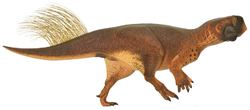| Kulceratops Temporal range: late Albian ~ | |
|---|---|
| Scientific classification | |
| Domain: | Eukaryota |
| Kingdom: | Animalia |
| Phylum: | Chordata |
| Clade: | Dinosauria |
| Clade: | † Ornithischia |
| Clade: | † Ceratopsia |
| Clade: | † Neoceratopsia |
| Genus: | † Kulceratops Nesov, 1995 |
| Type species | |
| †Kulceratops kulensis Nesov, 1995 | |
Kulceratops is a genus of ceratopsian dinosaur from the Early Cretaceous. It lived in the late Albian stage. It is one of the few ceratopsians known from this period. However, the fossils from this genus have been sparse: only jaw and tooth fragments have been found so far.




